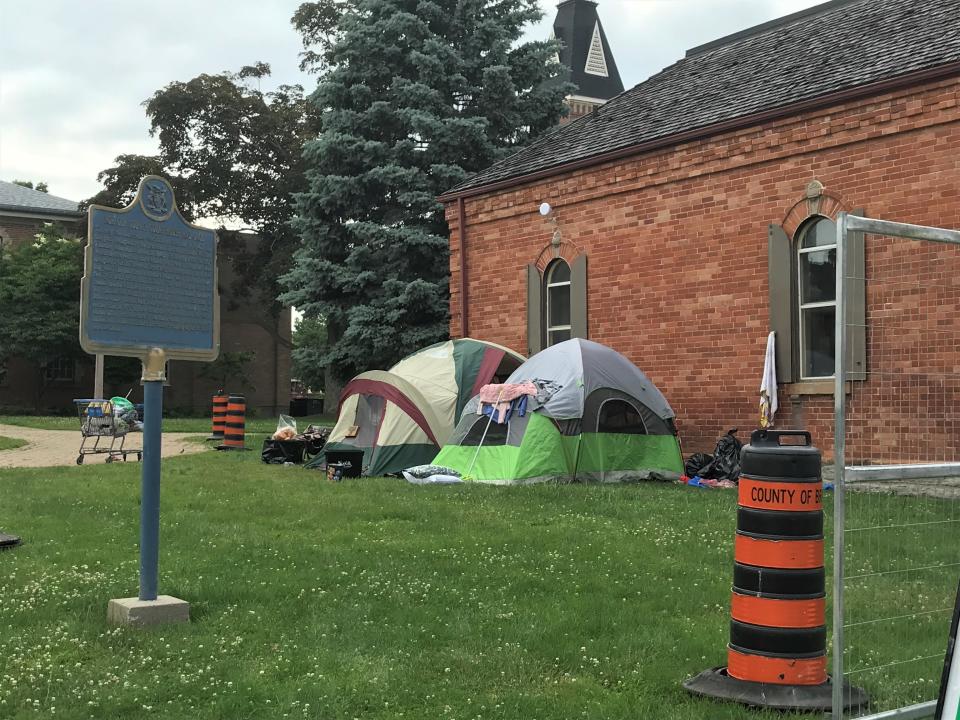‘We do not have housing’: Growing downtown encampment highlights homelessness problem in Simcoe
A row of tents leaning against the back wall of Talbot Gardens — a hockey arena in downtown Simcoe — has Norfolk County council worried about a rise in homelessness.
“While we can see the five or seven tents at Talbot, this is a much larger problem,” Sarah Page, Haldimand-Norfolk’s general manager of social services, told councillors at a recent special meeting to discuss the encampment.
The tents started to go up in mid-May, a few weeks after a nearby overnight warming shelter run by local non-profit group Church Out Serving closed for the season.
Residents of downtown Simcoe’s first substantial homeless encampment have since settled in, with chairs, tables, mattresses and assorted belongings piled against the wall near parking spots used by county staff and hockey parents, and within sight of a row of businesses across the street.
Tents have also appeared in the front yard of nearby Governor Simcoe Square, steps from the doors of Simcoe’s town hall and library.
The encampments in Simcoe — and another in Hagersville — are “more visible” evidence of a “systemic issue” that sees more and more people “struggling on a daily basis” to meet their basic needs due to poverty, a lack of health care and addictions treatment, and the rising cost of housing, food and utilities, Page said.
“They’re the end result of a much larger problem,” she said.
In Haldimand-Norfolk, more than 400 households need rent-geared-to-income housing and the wait time is two to 10 years “at best,” Page added.
Most people on the wait-list already receive social assistance, but meagre Ontario Works and Ontario Disability Support Program rates do not cover housing expenses.
The average house in Haldimand-Norfolk costs $676,000, while average rent for a one-bedroom apartment is $1,100.
“It was $882 a year ago,” Page said, noting the rental vacancy rate is 0.4 per cent.
“It means we do not have housing,” Page told councillors.
Haldimand-Norfolk’s homelessness prevention team helped more than 15,000 households last year with a host of services, including transitional housing and emergency shelter in the 16 beds available between the two counties.
An eviction prevention program allowed 400 households to stay in their homes by covering rent and utility arrears.
The team makes daily visits to the encampment site and tries to connect its inhabitants with the services they need to get safely housed.
Page dispelled a rumour the county outfitted the encampment residents with tents and other supplies needed to stay on the street.
“We have not provided the tents, mattresses, chairs, anything that’s out there,” Page said.
Page suggests residents wanting to help donate to local organizations that reduce food insecurity and provide emergency shelter, such as Church Out Serving, St. Leonard’s, the Salvation Army, and local food banks.

Some downtown residents and business owners have asked why the encampment is allowed to stay, but Mayor Amy Martin said it is not as simple as carting the tents away.
In response to legal challenges against evicting encampments in other cities, the courts have ruled municipalities do not have the “legal authority” to violate encampment residents’ human rights, Martin said.
Coun. Linda Vandendriessche encouraged those living in the shadow of the arena to accept the county’s offer of help.
“We’re doing a lot,” Vandendriessche said. “I don’t mind the hand up, but I’m tired of giving the handout.”
Passersby and visitors to the popular arena “have to cope with” open drug use, alleged drug trafficking and violence, Vandendriessche said.
“This is a delicate issue in our community,” said Simcoe representative Coun. Alan Duthie, urging residents “to treat (those in the encampment) with kindness.”
“Many Canadians are just a few missed paycheques away from being homeless,” said Duthie, adding he was dismayed to have heard reports of people throwing things at the tents and squealing their car tires and revving their engines overnight near the encampment.
“I think that we’re better than that,” Duthie said.
Page said all county departments are working together to tackle the affordable housing problem, but help is needed from Queen’s Park.
Martin asked staff to draw up a business case to take to the province. For a start, the mayor wants to know how much it would cost to house and support all 100-plus people on Haldimand-Norfolk’s “by-name” list of those who are currently homeless or at imminent risk of end up on the street.
“This is not the municipal taxpayer’s responsibility to provide all these services and be reactive,” Martin said.
J.P. Antonacci, Local Journalism Initiative Reporter, The Hamilton Spectator


